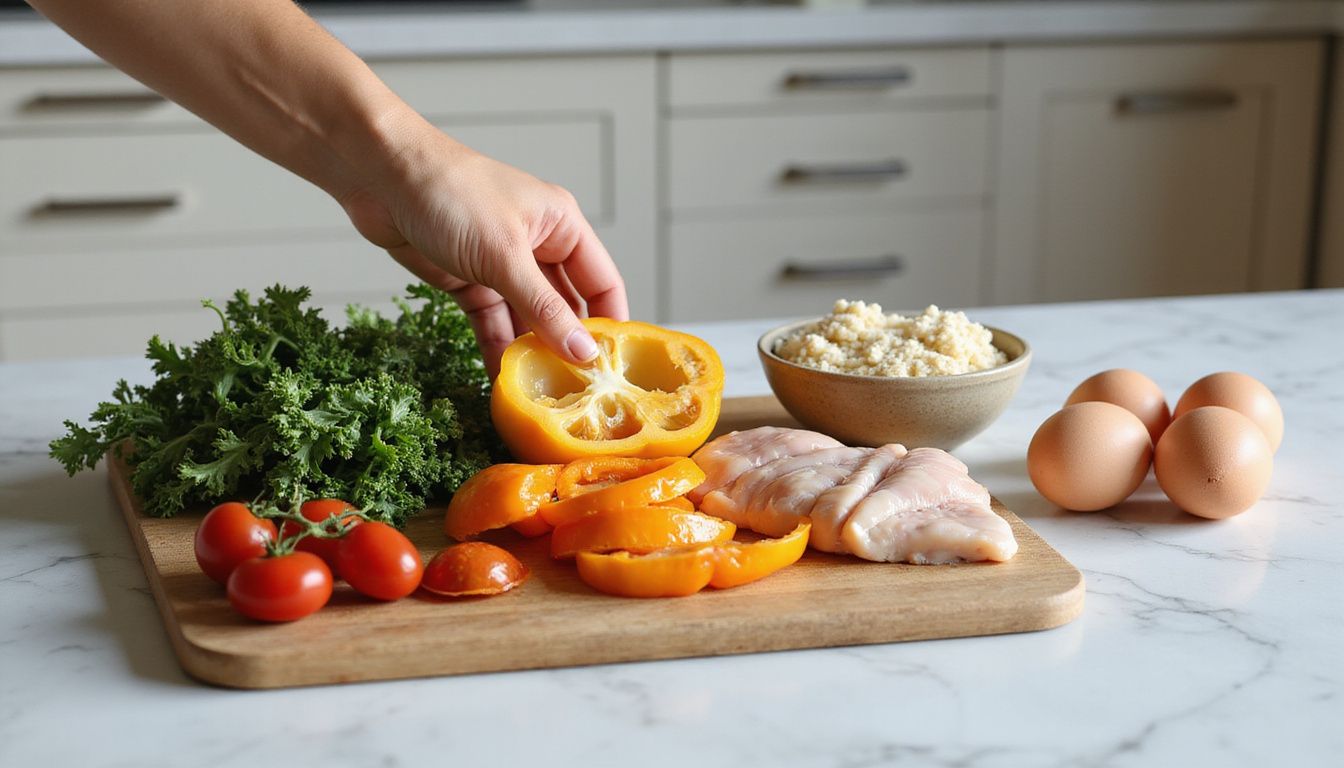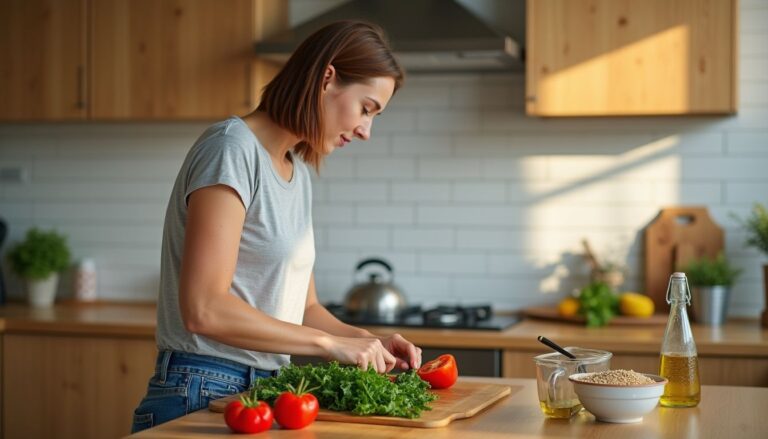Delicious Low Calorie High Protein Recipes For A Healthy Lifestyle
Our Nutrition Assistant AI Suite will transform your body. You will lose fat, get toned, and build muscle. Gain confidence and optimal health.
You want meals that help with weight goals and still taste great. Choosing low calorie, high-protein foods can keep you full longer and protect muscle, especially during weight loss.[1]
In this guide, you will find simple high-protein recipes, smart meal prep tips, and staple ingredients that fit a healthy lifestyle. Expect clear steps, quick swaps, and ideas you can use today.
Get ready to enjoy better food without feeling hungry.
…
[1] Paddon-Jones, D., & Leidy, H. (2014). Dietary protein and muscle in older persons: An update. Current Opinion in Clinical Nutrition & Metabolic Care, 17(1), 5-11.
Key Takeaways
- High-protein, low-calorie meals improve fullness and muscle support. A breakfast with 30 grams of protein reduced total daily calories in one study (Obesity, 2015).
- Protein has a higher thermic effect, the extra calories your body spends to digest food, at about 20 to 30 percent compared with carbs at 5 to 10 percent and fat at 0 to 3 percent.
- Cooking at home with lean proteins and vegetables helps you avoid added sugars and fats common in processed foods, which are linked with an 18 percent higher obesity risk (AJCN, 2022).
- Meals that pair protein and fiber, such as chickpeas or egg whites with vegetables, raise satiety hormones and lower hunger hormones (Leidy HJ et al., J Nutr 2015).
- Consistent meal planning with high-protein recipes, like spinach omelets or shrimp stir-fry, supports weight goals and steady energy (Paddon-Jones & Leidy, Curr Opin Clin Nutr Metab Care, 2014).

Benefits of Low-Calorie, High-Protein Recipes

Low-calorie, high-protein recipes let you eat satisfying meals while staying within your calorie target. They are simple to make and help you meet daily protein needs without extra fat or sugar.
How do these recipes help with weight management?
Protein increases satiety, which means you feel full sooner and stay full longer. Lean chicken, lentils, strained yogurt, and tofu are strong choices that may reduce later calorie intake.
In one trial published in Obesity, adults who ate 30 grams of protein at breakfast ate fewer calories the rest of the day. Picking recipes high in protein and lower in sugar supports a steady calorie budget.
Combining protein and fiber slows digestion. A chickpea bowl or a vegetable omelet leaves you satisfied and less likely to snack between meals.
I switched my afternoon snack to cottage cheese with tomato. My evening cravings dropped, and the scale finally started moving in the right direction.
“Protein helps preserve muscle while burning fat during weight loss,” says Dr. Heather Leidy of Purdue University.
How do they support muscle growth and repair?
Protein supplies amino acids, the building blocks your muscles use to repair after workouts. Lean chicken, Greek yogurt, tofu, tuna, and eggs all provide high-quality protein.
A post-workout meal with at least 20 grams of protein can aid recovery. Salmon is a smart pick because omega-3 fats in fish may also support healing.
When I began lifting, I cooked simple turkey stir-fries and egg white omelets with spinach. My workouts felt stronger within weeks, and soreness faded faster.
Adding foods like cottage cheese or grilled meat to lunch or dinner can boost endurance whether you lift weights or do cardio.
Can these meals keep you full longer?
Protein digests more slowly than many carbs or fats, which helps you feel full for longer. Research from Harvard and the Journal of Nutrition links protein-rich meals to higher satiety hormones and lower hunger hormones.
A breakfast with Greek yogurt or eggs usually beats cereal for staying power. Pair protein with vegetables for added fiber and even better fullness.
On higher protein days, I notice fewer snack attacks between meals. Lean chicken or legumes keep my appetite steady through busy afternoons.
…
Do high-protein meals increase metabolic rate?
Yes. Protein raises diet-induced thermogenesis, the energy your body spends to digest and process food. That can mean more calories burned in a day, even at rest.
The thermic effect of protein averages 20 to 30 percent of calories consumed. Carbohydrates average 5 to 10 percent, and fats average 0 to 3 percent.
Simple choices help. Mix protein powder into Greek yogurt or plan chicken or tofu for dinner. I felt more alert during the day after shifting toward protein at each meal.
Tips for Preparing High-Protein, Low-Calorie Meals
With a bit of planning, you can build meals that are filling, balanced, and quick to assemble.
How can I plan my meals ahead effectively?
Start with a weekly plan. Pick 2 to 3 breakfast ideas, 3 to 4 lunches, and 3 dinners. Include one high protein snack for busy days.
- List lean protein sources like chicken breast, Greek yogurt, tofu, beans, and eggs.
- Add produce such as bell peppers, broccoli, spinach, and cauliflower for fiber and vitamins.
- Batch cook grains or legumes, for example bulgur or chickpeas, to speed up weekday meals.
- Prep sauces like lemon-dill yogurt or a simple olive oil and lemon mix.
- Store pre-cut vegetables and cooked proteins in airtight containers.
Track portions so you hit protein targets while keeping calories low. A little prep on Sunday makes weeknights easier and helps you skip processed options.
What are the best lean protein sources to choose?
Choose lean meats and plant proteins that give you more protein per calorie.
- Poultry: chicken breast, turkey, and pork tenderloin are low in fat and high in protein.
- Seafood: cod, salmon, and shrimp offer protein with helpful omega-3 fats in certain fish.
- Plant options: tofu, tempeh, lentils, beans, chickpeas, and pea protein products fit vegetarian and vegan plans.
- Dairy: Greek yogurt and cottage cheese provide protein with fewer saturated fats than many cheeses.
- Egg whites: high protein with almost no fat.
Mix these sources through the week for variety and complete nutrition.
How do I combine protein with vegetables and healthy fats?
Build a plate with three parts, a lean protein, plenty of vegetables, and a small portion of healthy fat. This balance supports fullness and stable energy.
- Combine grilled chicken, tofu, or strained yogurt with leafy greens, cucumbers, or roasted vegetables.
- Season with paprika, chili powder, garlic, or lemon for flavor without extra calories.
- Finish with a small amount of olive oil, nuts, or seeds for healthy fats and crunch.
For a quick lunch, layer boiled egg slices, pickled cucumber, and a thin spread of peanut butter on whole grain bread. It is simple, filling, and easy to pack.
Why is home-cooked food better than processed options?
Cooking at home gives you control over salt, sugar, and fat. You can choose fresh produce, lean meats, low-fat dairy, and whole grains that support health.
Highly processed foods often include added sugars and unhealthy fats, which raise calorie density while lowering nutrient quality. A 2022 American Journal of Clinical Nutrition study linked higher processed food intake with an 18 percent rise in obesity risk.
Baking, roasting, or grilling reduces added fats compared with frying. I noticed steadier energy once I swapped takeout for simple home-cooked meals and used protein powder only when needed.
Plan a few recipes ahead to set up your week and make healthy choices easier.
Energizing High-Protein Breakfast Ideas
A strong breakfast can steady your appetite and energy until lunch. These options are quick, tasty, and high in protein.
How do I make a spinach and egg white omelet?
A spinach and egg white omelet is light, fast, and packed with protein. Here is a simple method.
- Gather 4 large egg whites, 1 cup fresh spinach, salt, pepper, and cooking spray or 1 teaspoon olive oil.
- Wash and pat the spinach dry.
- Whisk egg whites with a pinch of salt and pepper until slightly foamy.
- Heat a nonstick pan over medium heat, then add cooking spray or oil.
- Sauté spinach for about 1 minute until wilted.
- Pour in egg whites to cover the spinach evenly.
- Cook until edges set. Lift edges so uncooked egg flows under.
- Fold in half once set but still moist on top, then cook 30 seconds more.
- Serve with sliced tomatoes or fruit for a balanced plate.
- If desired, use a small amount of unflavored protein supplement to raise protein.
This omelet delivers about 17 grams of protein and stays low in calories. It works for breakfast or a fast dinner.
Source: U.S. Department of Agriculture FoodData Central
What is a simple recipe for Greek yogurt parfait with berries and chia seeds?
This parfait is creamy, bright, and ready in minutes. It makes a great breakfast or high protein snack.
- Place 3/4 cup Greek yogurt in a glass or bowl.
- Add 1/3 cup berries such as strawberries, blueberries, or raspberries.
- Sprinkle 1 tablespoon chia seeds for added protein and fiber.
- Drizzle 1 teaspoon honey for light sweetness.
- Layer another scoop of yogurt if you want more volume.
- Top with chopped almonds or walnuts for crunch and healthy fats.
- Assemble in a jar the night before for busy mornings.
- Pick low-fat Greek yogurt to keep calories down while staying high in protein.
Use the same layering idea with sliced apples or a spoon of protein powder blended into the yogurt.
How can I prepare protein-powder pancakes?
These pancakes add protein without a long ingredient list. They cook fast and freeze well.
- Choose a low-fat protein powder with at least 15 to 20 grams of protein per scoop.
- Mix 1 scoop protein powder, 2 egg whites, 3 tablespoons oat or whole wheat flour, and 1/4 cup unsweetened almond milk.
- Stir until smooth, but do not over-mix.
- Heat a nonstick skillet over medium heat and lightly oil it.
- Pour small circles of batter. Cook 1 to 2 minutes per side, flipping when bubbles form.
- Top with berries or diced apples for sweetness without heavy syrup.
- Add cinnamon or vanilla for flavor.
- Serve warm for an energizing start that keeps you full longer than a sugary breakfast.
Making them at home lets you control ingredients and avoid excess sugar or fillers.
Quick and Nutritious Lunch Options
These lunches deliver protein and fiber in under 20 minutes. They travel well and support steady energy at work or school.
How do I make a grilled chicken salad with lemon dressing?
This salad is crisp, bright, and rich in protein. It is an easy meal for dinner tonight or lunch tomorrow.
- Use 4 ounces grilled chicken breast.
- Fill a bowl with mixed greens such as spinach and arugula.
- Add sliced cucumbers, cherry tomatoes, and red onion.
- Slice the chicken and place it on top.
- Whisk 2 tablespoons lemon juice, 1 teaspoon olive oil, a pinch of salt, pepper, and minced garlic.
- Toss salad with the dressing.
- For variety, add chickpeas or a small amount of diced avocado.
What are the steps to prepare tuna and avocado wraps?
These wraps are creamy, savory, and high in protein. They also work with plant swaps if you need them.
- Drain one can of tuna packed in water.
- Mix with diced avocado for healthy fats and potassium.
- Add a squeeze of lemon for brightness.
- Stir in chopped tomatoes, red onion, or spinach.
- Use a whole wheat wrap or low-calorie flatbread.
- Spread the filling evenly across the wrap.
- Roll tightly and slice in half.
- Serve chilled or at room temperature.
- Swap mashed chickpeas for tuna if you want a plant-based version.
You get satisfying protein, fiber, and healthy fats without the heavy calories of fast-food sandwiches.
How can I create a lentil and quinoa bowl with vegetables?
This bowl is hearty and flexible. It stores well, which makes it great for meal prep.
- Cook 1 cup quinoa in 2 cups water, about 15 minutes.
- Boil 1/2 cup green or brown lentils until tender, about 20 minutes.
- Dice carrots, bell peppers, and broccoli.
- Sauté vegetables in 1 tablespoon olive oil for 5 minutes.
- Toss warm quinoa and lentils with the vegetables.
- Season with lemon juice, pepper, salt, and a pinch of cumin.
- Add spinach or kale for extra fiber and vitamins.
- Top with toasted pumpkin seeds or sliced avocado if desired.
- Pack portions in containers for the week.
I usually prep two bowls on Sunday night. Lunch is solved, and I avoid last-minute takeout.
Satisfying High-Protein Dinner Recipes
Dinners that are high in protein help your muscles recover after a long day. These options are flavorful, quick, and light on calories.
How do I bake salmon with steamed asparagus?
Salmon with asparagus is simple and elegant. It is a complete plate with protein, fiber, and key minerals.
- Preheat oven to 400°F.
- Place a skinless salmon fillet on a parchment-lined sheet. Season with salt, pepper, and lemon juice.
- Add fresh dill or parsley.
- Arrange trimmed asparagus beside the salmon. Drizzle 1 teaspoon olive oil and a pinch of sea salt.
- Bake 15 to 18 minutes, until the fish flakes and asparagus is tender.
- Serve immediately with an extra lemon wedge.
- Expect about 25 grams of protein per serving plus minerals that support muscle health.
What is a recipe for turkey and quinoa stuffed bell peppers?
Stuffed peppers are colorful and filling. They reheat well for busy nights.
- Preheat oven to 375°F.
- Cut tops off 4 bell peppers and remove seeds.
- Cook 1/2 cup quinoa in 1 cup water.
- Brown 1/2 pound lean ground turkey in a skillet.
- Add 1 diced onion and 2 minced garlic cloves. Cook until soft.
- Stir in cooked quinoa, 1 cup diced tomatoes, 1 teaspoon Italian seasoning, salt, and pepper.
- Fill each pepper with the mixture.
- Set peppers in a baking dish. Pour 1/2 cup low-sodium broth around them.
- Cover with foil and bake 35 minutes. Uncover and bake 10 minutes more.
- Top with 1 tablespoon shredded part-skim mozzarella if desired.
- Save leftovers for lunch the next day.
This meal blends lean protein, fiber, and vegetables into a balanced plate that fits many high-protein recipes for weight control.
How do I make shrimp and vegetable stir-fry?
Stir-fry is fast and flexible. Shrimp cooks in minutes, which makes this perfect for weeknights.
- Peel and devein medium shrimp. Three ounces cooked provides about 20 grams of protein.
- Chop bell peppers, broccoli, snow peas, or carrots.
- Heat 1 tablespoon olive oil in a skillet over medium-high heat.
- Sauté shrimp for 2 to 3 minutes until pink. Remove from the pan.
- Cook vegetables for 3 to 4 minutes, stirring often.
- Add minced garlic and a splash of low-sodium soy sauce.
- Return shrimp to the pan and toss 1 minute.
- Serve over riced cauliflower or quinoa.
- Garnish with green onions or sesame seeds.
I make this after long workdays. It fuels my evening workout without feeling heavy.
Snacks for Sustained Energy
Smart snacks can steady your energy between meals. Choose options that are high in protein and rich in fiber.
How do I prepare roasted chickpeas?
Roasted chickpeas are crunchy, savory, and easy to batch cook.
- Preheat oven to 400°F.
- Rinse and drain a 15 ounce can of chickpeas. Pat dry well.
- Spread on a parchment-lined sheet.
- Toss with 1 tablespoon olive oil.
- Season with paprika, garlic powder, cumin, or black pepper.
- Roast 25 to 30 minutes, stirring halfway.
- Cool to crisp. They firm up as they cool.
- Store in an airtight container for up to 3 days.
This snack curbs hunger and travels well in a lunch bag.
What is a healthy way to serve cottage cheese with diced tomatoes?
This savory bowl comes together in under 5 minutes and delivers steady protein.
- Choose low-fat or fat-free cottage cheese.
- Dice ripe tomatoes.
- Spoon 1/2 cup cottage cheese into a bowl, then top with tomatoes.
- Season with black pepper or dried oregano.
- Add chopped green onions or chives.
- Drizzle 1 teaspoon olive oil if you want healthy fats.
- Stir in a handful of baby spinach if you like.
- Serve chilled as a snack or light meal.
- One serving provides roughly 18 grams of protein.
This combination is fresh, budget friendly, and very filling.
How can I enjoy apple slices with almond butter?
This sweet and salty pairing delivers fiber and plant-based protein.
- Pick a crisp apple and wash it well.
- Slice into even wedges.
- Choose unsweetened almond butter.
- Spread a thin layer of almond butter on each slice.
- Sprinkle cinnamon or chia seeds if desired.
- Pack in a container for busy afternoons or post-workout.
- Chill slices if prepping early in the day.
You can now explore more plant-forward ideas below.
Plant-Based Protein-Rich Recipes
Plant-based protein can be just as satisfying as meat. These recipes are easy, flavorful, and budget friendly.
How do I make coconut curry tofu?
Tofu simmers in a creamy, spiced sauce for a cozy dinner. Light coconut milk keeps calories reasonable.
- Drain a 14 ounce block of extra-firm tofu for at least 10 minutes. Cut into cubes.
- Heat 1 tablespoon olive oil in a skillet over medium heat. Brown tofu on all sides, 6 to 8 minutes. Remove.
- Cook 1 diced onion and 2 minced garlic cloves until soft.
- Stir in 1 tablespoon curry powder and 1 teaspoon ground ginger. Toast 1 minute.
- Pour in 1 can, about 13 ounces, light coconut milk. Stir well.
- Add chopped bell pepper or spinach.
- Simmer 5 minutes to thicken slightly. Return tofu to the pan.
- Toss gently and heat 3 minutes.
- Serve over cooked quinoa or brown rice.
Each serving paired with grains can reach about 20 grams of protein, depending on portion size.
What is the recipe for lentil soup with spinach?
This soup is warm, filling, and simple to scale up for leftovers.
- Rinse 1 cup dried lentils.
- Heat 1 tablespoon olive oil in a pot over medium heat.
- Sauté 1 chopped onion, 2 minced garlic cloves, and 2 diced carrots for 5 minutes.
- Add lentils and 6 cups low-sodium vegetable broth.
- Season with 1 teaspoon cumin and 1 teaspoon coriander.
- Bring to a boil, then simmer 20 to 25 minutes until tender.
- Stir in 3 cups fresh spinach for the last 3 minutes.
- Adjust salt and pepper. Serve with lemon wedges.
This bowl provides protein, fiber, and vitamins A and C, usually under 300 calories per serving.
How can I prepare chickpea and vegetable stir-fry?
This is a quick skillet meal that highlights pantry ingredients and seasonal produce.
- Rinse and drain a can of low-sodium chickpeas.
- Chop bell peppers, red onion, carrot, and broccoli.
- Heat 1 tablespoon olive oil in a large skillet over medium-high heat.
- Sauté onions and carrots for 2 minutes.
- Add bell peppers and broccoli. Cook 3 to 4 minutes.
- Stir in chickpeas and 2 teaspoons low-sodium soy sauce or tamari.
- Add black pepper or chili flakes. Squeeze lemon before serving.
- Serve alone or over quinoa.
- Refrigerate leftovers for up to 2 days.
I often make this after the gym. It takes 15 minutes and leaves me full without feeling heavy.
High-Protein, Low-Calorie Dessert Ideas
You can enjoy dessert and still meet your goals. These treats are sweet, simple, and packed with protein.
How do I serve Greek yogurt with honey and nuts?
This dessert brings creamy yogurt, a hint of honey, and crunchy nuts together.
- Add 3/4 cup plain nonfat Greek yogurt to a bowl, about 17 grams of protein and just under 110 calories.
- Drizzle 1 teaspoon raw honey, around 20 calories.
- Sprinkle 1 tablespoon chopped walnuts or almonds, about 45 to 50 calories.
- Stir lightly or leave layered.
- Top with cinnamon or berries.
- Serve right away for best texture.
- Use single-serve cups for grab-and-go snacks.
It is a quick way to end a meal without a sugar crash.
What is an easy protein-packed chocolate mug cake recipe?
This microwave mug cake satisfies chocolate cravings fast and keeps protein high.
- Add 1 scoop chocolate protein powder to a microwave-safe mug.
- Mix in 2 tablespoons unsweetened cocoa powder.
- Stir in 1 tablespoon whole wheat or almond flour.
- Add 1/4 teaspoon baking powder.
- Crack in 1 large egg.
- Pour in 2 tablespoons unsweetened almond milk.
- Sweeten with 1 to 2 teaspoons stevia if desired.
- Whisk until smooth.
- Microwave about 1 minute. A toothpick should come out clean.
- Cool 2 minutes.
- Top with berries or a spoon of plain yogurt.
Expect around 20 grams of protein per serving, depending on your powder.
How can I make chia seed pudding with almond milk?
Chia seeds thicken in the fridge and create a pudding-like texture with minimal work.
- Add 3 tablespoons chia seeds to a jar. An ounce has about 5 grams of protein and 10 grams of fiber.
- Pour in 1 cup unsweetened almond milk.
- Stir in 1/2 teaspoon vanilla and a pinch of sea salt.
- Mix well. Wait 2 minutes and stir again to prevent clumps.
- Cover and chill for at least 6 hours or overnight.
- Top with Greek yogurt, sliced almonds, or berries.
- Enjoy for breakfast or a high-protein snack.
Essential Foods for a High-Protein, Low-Calorie Diet
Pick foods that deliver more protein per calorie. This helps preserve muscle and reduce hunger while staying within your calorie plan.
Which lean meats should I include?
Focus on cuts that are low in saturated fat and high in protein.
- Skinless chicken breast, turkey breast, and extra-lean ground turkey provide about 23 to 26 grams of protein per 3 ounce cooked serving with less than 4 grams of fat.
- Pork tenderloin offers around 22 grams of protein with about 3 grams of fat.
- Center-cut pork chops and beef sirloin add iron and zinc with fewer calories than fattier cuts.
- White fish like cod or tilapia supply over 20 grams of protein with very little fat.
Rotate different proteins during the week to cover nutrients and prevent boredom.
What are good plant-based protein options?
Plant proteins add fiber, vitamins, and minerals along with protein. They also store well and cost less per serving.
- Beans and lentils: black beans about 15 grams per cooked cup, lentils about 18 grams.
- Soy options: tofu and tempeh deliver 10 to 20 grams per serving.
- Edamame: about 17 grams per cup.
- Quinoa: roughly 8 grams per cooked cup and considered a complete protein.
- Nuts and seeds: almonds or peanuts about 6 to 7 grams per small handful. Chia or hemp seeds add easy boosts to meals.
What low-fat dairy products are best for this diet?
Pick dairy that keeps protein high and saturated fat low.
- Skim milk has about 8 grams of protein for only 90 calories per cup.
- Greek yogurt often doubles the protein of regular yogurt. Many cups offer 15 grams for a little over 100 calories.
- Low-fat cottage cheese is a versatile base for sweet or savory snacks.
- Part-skim options like mozzarella sticks or ricotta can add variety.
Check labels for added sugars, especially in flavored yogurt. I like to stir plain Greek yogurt into scrambled eggs for extra creaminess and more protein.
Foods to Avoid in a High-Protein, Low-Calorie Diet
Certain foods can slow your progress. Limiting them makes it easier to stay on track while keeping protein high.
Which high-fat meats should be limited?
Try to limit bacon, sausage, salami, and regular ground beef. These meats are high in saturated fat, which can raise LDL cholesterol and increase heart risk.
Even a single slice of bacon has about 3 grams of fat. Sausage patties often contain 9 to 13 grams per serving. Fried chicken with skin adds extra calories and fat without improving protein quality.
Choose lean cuts like turkey breast or trimmed sirloin instead. You will lower calories while keeping meals satisfying.
Why should sugary snacks and beverages be reduced?
Sugary drinks and snacks often add calories with little nutrition. They can spike blood sugar, then drop it, which leads to more hunger and fatigue.
Higher added sugar intake is linked to weight gain and a higher risk of diabetes and heart disease. The CDC warns that getting more than 10 percent of daily calories from added sugar raises metabolic risks.
Swap in high-protein choices such as Greek yogurt, nuts, or a small protein shake. Many people feel better after replacing soda with water or unsweetened tea.
What processed foods are best avoided?
Skip highly processed foods like packaged snacks, instant noodles, and many frozen meals. They often contain excess sodium, unhealthy fats, and added sugars.
Processed meats such as hot dogs and some deli meats can increase health risks due to saturated fats and preservatives. Replace sweetened protein bars and sugary cereals with whole foods or homemade snacks.
When I shifted to fresh fruit and roasted chickpeas, my workouts felt easier and my afternoon energy improved.
Conclusion
Low-calorie, high-protein recipes support weight management, preserve muscle, and keep you satisfied. Research also shows protein can raise daily calorie burn through digestion and processing.1,2,3
Cooking at home gives you control over ingredients and portions. Try spinach omelets, grilled chicken salad, shrimp stir-fry, or coconut curry tofu. Even desserts can fit, such as chia pudding or a Greek yogurt parfait.
Start with one change this week, for example add protein to breakfast or prep a high-protein lunch. Small steps add up and make healthy eating easier to keep.
This article is for education only and does not replace medical advice. If you have a medical condition, allergies, or specific nutrition needs, speak with a registered dietitian or healthcare professional.
…
- Leidy HJ et al., “The role of protein in weight loss and maintenance,” Am J Clin Nutr, 2015.
- Westerterp KR., “Diet induced thermogenesis,” Nutr Metab (Lond), 2004.
- Paddon-Jones D et al., “Protein ingestion supports muscle growth,” Curr Opin Clin Nutr Metab Care, 2009.
FAQs
1. What are some examples of delicious low calorie high protein recipes for a healthy lifestyle?
Grilled chicken salad, cottage cheese with berries, and baked cod with steamed vegetables are all excellent choices. These meals provide lean animal-based proteins and keep calories in check. For plant-based options, try lentil soup or tofu stir-fry.
2. How do low calorie high protein recipes support weight management?
Research shows that eating more protein helps people feel full longer while reducing overall calorie intake (Leidy et al., 2015). High-protein foods also help maintain muscle mass during weight loss efforts.
3. Can I prepare these recipes quickly on busy days?
Many low calorie high protein dishes require minimal preparation time. For example, scrambled eggs with spinach can be ready in under ten minutes; grilled turkey breast takes about fifteen minutes to cook.
4. Are there risks to following a diet focused on low calories and high protein?
Most healthy adults tolerate this approach well when they include varied sources of nutrients (Phillips & Fulgoni, 2016). However, those with kidney disease should consult a healthcare provider before increasing their dietary protein.
Summary: Choosing meals like grilled poultry salads or lentil soups supports satiety and muscle health without excess calories. Quick preparation is possible for most dishes; always consider individual health needs when changing your diet plan.







